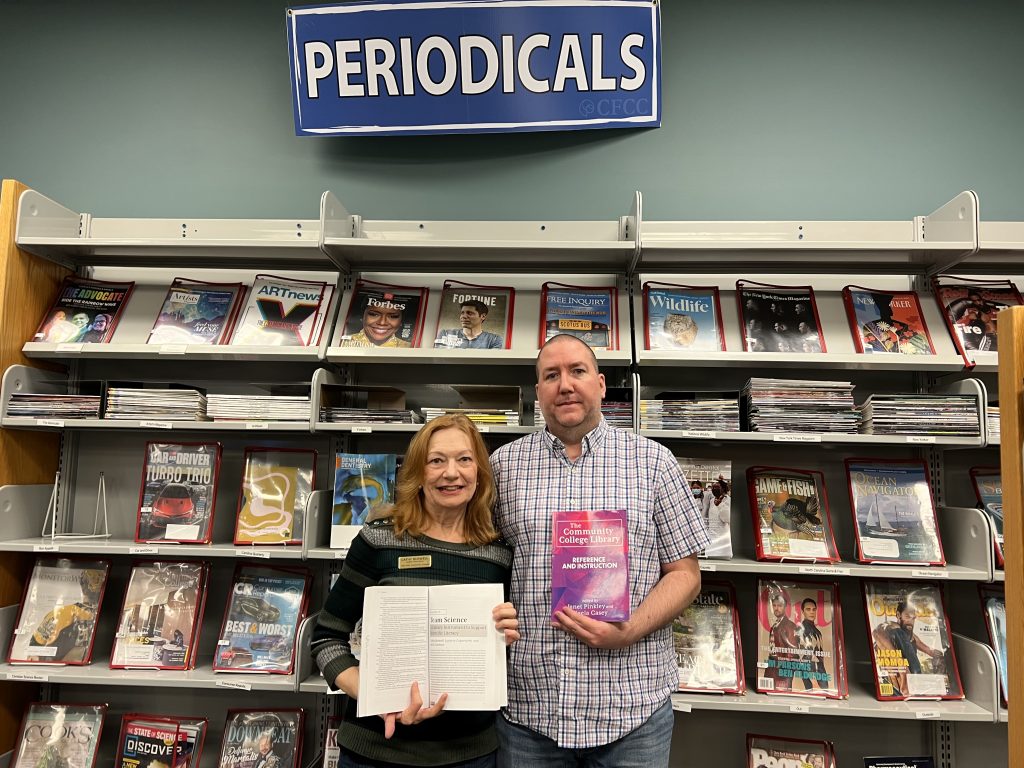Team Science: A Library Instrument to Support Scientific Literacy

Cathy Burwell, Assistant Director of the CFCC Library, and Alvin Coleman, CFCC Geology Instructor
In their chapter titled “Team Science: A Library Instrument to Support Scientific Literacy,” Burwell and Coleman offer a targeted approach to reading scientific papers. They designed a reading exercise that educators can seamlessly integrate into their lessons to assist students in comprehending such material.
REASONING BEHIND THE EXERCISE
“As someone who has been teaching here for almost 15 years, I remember reaching out to the library for supplemental instruction or resources to help my students improve their writing skills,” said Coleman.
“As time passed, I realized effective reading skills were crucial for my students to write quality papers for assigned topics. Reading and writing skills are intertwined, requiring equal attention to excel in academic writing.”
Burwell and Coleman’s exercise was initially intended to focus specifically on biology or geology. However, they realized that all sciences face a common challenge. First and second-year students who have not yet been exposed to statistics or scholarly materials tend to approach these subjects by reading from start to finish. However, when encountering materials and methods, charts, graphs, and statistics, they often struggle to comprehend the content.
To address this issue, they made a concerted effort to create an exercise that is as generic as possible, allowing it to be applied across all natural and applied sciences. Instructors can modify the exercise to suit their class needs.
SELECTING ACCESSIBLE AND LABELED ARTICLES
In addition, CFCC librarians are available to assist instructors and students in selecting articles for their classes.
“We can find articles where the standard sections, such as introduction, results, and discussions, are appropriately labeled,” said Burwell. It is surprising how many articles lack such labeling, making it especially challenging for beginners to navigate. We also ensure the articles are accessible.”
PROMOTING SUCCESS AND CONFIDENCE
By providing students with the necessary tools to navigate scholarly articles, instructors can promote both success and confidence in their students.
“It’s important not to simply throw students into unfamiliar territory without support,” said Burwell. “Instead, by taking a step back and acknowledging that students may not have experience in this area, instructors can help students develop the skills to read and understand scholarly articles. By achieving this goal, students will feel empowered to take on future challenges.”
Additionally, this approach can help alleviate the anxiety that often arises when students are tasked with reading papers that do not reveal a hypothesis or other critical information. In such cases, students can learn to recognize when a piece is more descriptive in nature.
“It’s okay not always to have an answer,” said Coleman. “Not every question has a straightforward answer, and there are alternative ways to answer a question if you don’t have one.”
INCORPORATING THE EXERCISE IN CLASS
A copy of The Community College Library: Reference and Instruction book is available in the library and can be checked out anytime (Z 675 .J8 C6668 2022). If you want to try the reading exercise in your class, you can email Burwell or Coleman, who have physical copies available. If you require support in selecting articles for your students, feel free to contact the library.
Additionally, the exercise can be incorporated into our online platform. During the summer, they plan to create a shell of the reading exercise in our online platform for faculty. “I’ve observed that using a digital format for the reading exercise yields better responses in my class,” said Coleman. “It is more convenient for students to type than write.”
PROVING TO BE EFFECTIVE
According to feedback from CFCC instructors who have implemented the reading exercise in their classes, the response has been positive.
“My students learned how to properly search scientific journal article databases, how to determine whether a source is credible, and how to read a scientific article. The handout they created was very effective in helping students break down scientific journal articles into smaller, more digestible parts and to analyze each section of the articles critically. I hope this increases their scientific literacy, which is often lacking and can be a daunting task for many students.”
Jessica Snoberger, Biology Instructor
“I worked with Cathy for my nutrition course (BIO 155). I felt it was important for these students, especially those in the Health and Fitness Science program, to understand scholarly journals and where to find sound research on nutrition and fitness. There is so much bad information and advice about nutrition and fitness, and I think it is important to know what is good information and where to find it. Thanks to Cathy, there is a page on the CFCC library platform with specific information and journals for the nutrition course. I am excited to continue working with Cathy and my class this semester and into the future.”
Donna Uguccioni, Anatomy and Physiology Instructor

